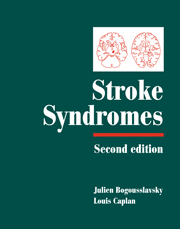Book contents
- Frontmatter
- Contents
- List of contributors
- Preface
- PART I CLINICAL MANIFESTATIONS
- 1 Stroke onset and courses
- 2 Clinical types of transient ischemic attacks
- 3 Hemiparesis and other types of motor weakness
- 4 Sensory abnormality
- 5 Cerebellar ataxia
- 6 Headache: stroke symptoms and signs
- 7 Eye movement abnormalities
- 8 Cerebral visual dysfunction
- 9 Visual symptoms (eye)
- 10 Vestibular syndromes and vertigo
- 11 Auditory disorders in stroke
- 12 Abnormal movements
- 13 Seizures and stroke
- 14 Disturbances of consciousness and sleep–wake functions
- 15 Aphasia and stroke
- 16 Agitation and delirium
- 17 Frontal lobe stroke syndromes
- 18 Memory loss
- 19 Neurobehavioural aspects of deep hemisphere stroke
- 20 Right hemisphere syndromes
- 21 Poststroke dementia
- 22 Disorders of mood behaviour
- 23 Agnosias, apraxias and callosal disconnection syndromes
- 24 Muscle, peripheral nerve and autonomic changes
- 25 Dysarthria
- 26 Dysphagia and aspiration syndromes
- 27 Respiratory dysfunction
- 28 Clinical aspects and correlates of stroke recovery
- PART II VASCULAR TOPOGRAPHIC SYNDROMES
- Index
- Plate section
23 - Agnosias, apraxias and callosal disconnection syndromes
from PART I - CLINICAL MANIFESTATIONS
Published online by Cambridge University Press: 17 May 2010
- Frontmatter
- Contents
- List of contributors
- Preface
- PART I CLINICAL MANIFESTATIONS
- 1 Stroke onset and courses
- 2 Clinical types of transient ischemic attacks
- 3 Hemiparesis and other types of motor weakness
- 4 Sensory abnormality
- 5 Cerebellar ataxia
- 6 Headache: stroke symptoms and signs
- 7 Eye movement abnormalities
- 8 Cerebral visual dysfunction
- 9 Visual symptoms (eye)
- 10 Vestibular syndromes and vertigo
- 11 Auditory disorders in stroke
- 12 Abnormal movements
- 13 Seizures and stroke
- 14 Disturbances of consciousness and sleep–wake functions
- 15 Aphasia and stroke
- 16 Agitation and delirium
- 17 Frontal lobe stroke syndromes
- 18 Memory loss
- 19 Neurobehavioural aspects of deep hemisphere stroke
- 20 Right hemisphere syndromes
- 21 Poststroke dementia
- 22 Disorders of mood behaviour
- 23 Agnosias, apraxias and callosal disconnection syndromes
- 24 Muscle, peripheral nerve and autonomic changes
- 25 Dysarthria
- 26 Dysphagia and aspiration syndromes
- 27 Respiratory dysfunction
- 28 Clinical aspects and correlates of stroke recovery
- PART II VASCULAR TOPOGRAPHIC SYNDROMES
- Index
- Plate section
Summary
Introduction and definitions
Lesions in primary sensory or motor cortices and pathways disrupt cerebral input or output functions, producing anesthesia, blindness, deafness, or paralysis. Most other brain areas are concerned with higher level processes that organize sensory input into meaningful perception and motor output into goal-directed action. Specialized streams of processing deal separately with different kind of information for different purposes (Fig. 23.1). For instance, visual cortical areas are divided into two major pathways: a ventral stream along occipito-temporal areas extracts object properties such as shapes or colour, allowing recognition and long-term memory of visual stimuli; whereas a dorsal stream along occipito-parietal areas encodes the spatial location, orientation, and motion of objects, subserving a variety of visuospatial capacities and visuomotor coordination. Besides, in right-handed subjects, the left hemisphere is usually dominant for linguistic and semantic functions, while the right hemisphere is dominant for spatial, attentional, and emotional behaviour. Focal damage to secondary and associative cortices, or to their connections in the white-matter and corpus callosum, cause specific behavioural and cognitive disorders, which have useful diagnostic value (Table 23.1), and often represent a major burden for patients and their relatives.
Agnosias are disorders in the recognition of objects not due to an impairment of elementary sensory processes, memory, language, and other general intellectual functions, and can be specific for a modality (vision, audition, touch) and a class of stimuli (e.g. objects, faces, or words). Visual agnosias follow damage to ventral visual areas, whereas spatial and visuomotor disorders follow damage to dorsal areas. Apraxias are disturbances in skilled and purposeful movements not due to elementary motor, sensory, or extrapyramidal dysfunction, and can involve one or more effectors (limb, orofacial, or eye movements).
- Type
- Chapter
- Information
- Stroke Syndromes , pp. 302 - 322Publisher: Cambridge University PressPrint publication year: 2001
- 2
- Cited by



